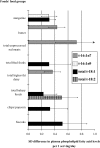Food sources of individual plasma phospholipid trans fatty acid isomers: the Cardiovascular Health Study
- PMID: 20219966
- PMCID: PMC2844676
- DOI: 10.3945/ajcn.2009.28877
Food sources of individual plasma phospholipid trans fatty acid isomers: the Cardiovascular Health Study
Erratum in
- Am J Clin Nutr. 2011 Mar;93(3):674
Abstract
Background: The overall consumption of trans fatty acids (TFAs) increases the risk of coronary artery disease. However, multiple TFA isomers exist, each with potentially different health effects. Different food sources of these specific TFA isomers are not well established.
Objective: Our objective was to determine the major independent food sources of specific TFA isomers.
Design: We investigated relations of major potential food sources of TFAs, as assessed by serial food-frequency questionnaires, with 10 plasma phospholipid TFA isomers [5 trans (t-) 18:1, 3 t-18:2, and 2 t-16:1] in 3330 older adults in the Cardiovascular Health Study, a community-based multicenter cohort. Stepwise regression was used to identify independent major food sources of individual plasma phospholipid TFA isomers, which were adjusted for demographic, lifestyle, and dietary factors.
Results: All 5 t-18:1 isomers were similarly associated with foods commonly made with partially hydrogenated vegetable oils (PHVOs), including biscuits (0.51 higher SD of total 18:1 fatty acid concentrations per serving/d, P < 0.01), chips and/or popcorn (0.33 higher SD per serving/d, P = 0.02), margarine (0.32 higher SD per serving/d, P < 0.001), fried foods (0.32 higher SD per serving/d, P = 0.04), and bakery foods (0.23 higher SD per serving/d, P = 0.02). Each of the t-18:2 isomers were associated only with bakery foods (0.50 higher SD of total 18:2 fatty acid concentrations per serving/d, P < 0.001). Ruminant foods were major correlates of t-16:1n-7, including red meats (0.72 higher SD per serving/d, P < 0.001), butter (0.43 higher SD per serving/d, P < 0.001), and higher-fat dairy (0.37 higher SD per serving/d, P < 0.001). In contrast, t-16:1n-9 were derived mainly from margarine (0.31 higher SD per serving/d, P < 0.001).
Conclusions: t-18:1 Isomers are similarly derived from multiple PHVO-containing foods. In contrast, t-18:2 and t-16:1n-9 isomers are derived from more-specific types of PHVO-containing foods. Ruminant foods are major sources of t-16:1n-7. Different TFA isomers and dietary sources should be considered when investigating health effects and interventions to lower TFAs.
Figures


Similar articles
-
Quantitative effects on cardiovascular risk factors and coronary heart disease risk of replacing partially hydrogenated vegetable oils with other fats and oils.Eur J Clin Nutr. 2009 May;63 Suppl 2:S22-33. doi: 10.1038/sj.ejcn.1602976. Eur J Clin Nutr. 2009. PMID: 19424216
-
Trans fatty acids: are its cardiovascular risks fully appreciated?Clin Ther. 2014 Mar 1;36(3):315-21. doi: 10.1016/j.clinthera.2014.01.020. Clin Ther. 2014. PMID: 24636816 Review.
-
Home use of margarine is an important determinant of plasma trans fatty acid status: a biomarker study.Br J Nutr. 2006 Aug;96(2):377-83. doi: 10.1079/bjn20061737. Br J Nutr. 2006. PMID: 16923234
-
Feasibility of recommending certain replacement or alternative fats.Eur J Clin Nutr. 2009 May;63 Suppl 2:S34-49. doi: 10.1038/sj.ejcn.1602974. Eur J Clin Nutr. 2009. PMID: 19424217
-
Role of trans fatty acids in health and challenges to their reduction in Indian foods.Asia Pac J Clin Nutr. 2008;17 Suppl 1:212-5. Asia Pac J Clin Nutr. 2008. PMID: 18296340 Review.
Cited by
-
Nutrient biomarker patterns, cognitive function, and MRI measures of brain aging.Neurology. 2012 Jan 24;78(4):241-9. doi: 10.1212/WNL.0b013e3182436598. Epub 2011 Dec 28. Neurology. 2012. PMID: 22205763 Free PMC article.
-
Effects of coconut oil, olive oil, and butter on plasma fatty acids and metabolic risk factors: a randomized trial.J Lipid Res. 2024 Dec;65(12):100681. doi: 10.1016/j.jlr.2024.100681. Epub 2024 Oct 28. J Lipid Res. 2024. PMID: 39490924 Free PMC article. Clinical Trial.
-
Erythrocyte trans-fatty acids, type 2 diabetes and cardiovascular risk factors in middle-aged and older Chinese individuals.Diabetologia. 2012 Nov;55(11):2954-62. doi: 10.1007/s00125-012-2674-2. Epub 2012 Aug 12. Diabetologia. 2012. PMID: 22886370 Free PMC article.
-
Associations of Serum Nonesterified Fatty Acids With Coronary Heart Disease Mortality and Nonfatal Myocardial Infarction: The CHS (Cardiovascular Health Study) Cohort.J Am Heart Assoc. 2021 Mar 16;10(6):e019135. doi: 10.1161/JAHA.120.019135. Epub 2021 Mar 8. J Am Heart Assoc. 2021. PMID: 33682438 Free PMC article.
-
Serial Plasma Phospholipid Fatty Acids in the De Novo Lipogenesis Pathway and Total Mortality, Cause-Specific Mortality, and Cardiovascular Diseases in the Cardiovascular Health Study.J Am Heart Assoc. 2019 Nov 19;8(22):e012881. doi: 10.1161/JAHA.119.012881. Epub 2019 Nov 12. J Am Heart Assoc. 2019. PMID: 31711385 Free PMC article.
References
-
- Mozaffarian D, Clarke R. Quantitative effects on cardiovascular risk factors and coronary artery disease risk of replacing partially hydrogenated vegetable oils with other fats and oils. Eur J Clin Nutr 2009;63(suppl 2):S22–33 - PubMed
-
- Mauger JF, Lichtenstein AH, Ausman LM, et al. Effect of different forms of dietary hydrogenated fats on LDL particle size. Am J Clin Nutr 2003;78:370–5 - PubMed
-
- Baer DJ, Judd JT, Clevidence BA, Tracy RP. Dietary fatty acids affect plasma markers of inflammation in healthy men fed controlled diets: a randomized crossover study. Am J Clin Nutr 2004;79:969–73 - PubMed
Publication types
MeSH terms
Substances
Grants and funding
- P30 DK040561/DK/NIDDK NIH HHS/United States
- N01-HC-85085/HC/NHLBI NIH HHS/United States
- N01-HC-85081/HC/NHLBI NIH HHS/United States
- N01-HC-85086/HC/NHLBI NIH HHS/United States
- N01-HC-85082/HC/NHLBI NIH HHS/United States
- N01-HC-85084/HC/NHLBI NIH HHS/United States
- U01 HL080295/HL/NHLBI NIH HHS/United States
- R01 HL085710/HL/NHLBI NIH HHS/United States
- N01-HC-35129/HC/NHLBI NIH HHS/United States
- N01 HC-55222/HC/NHLBI NIH HHS/United States
- N01-HC-85083/HC/NHLBI NIH HHS/United States
- N01-HC-75150/HC/NHLBI NIH HHS/United States
- N01-HC-85080/HC/NHLBI NIH HHS/United States
- N01 HC-15103/HC/NHLBI NIH HHS/United States
- N01-HC-45133/HC/NHLBI NIH HHS/United States
- N01-HC-85079/HC/NHLBI NIH HHS/United States
LinkOut - more resources
Full Text Sources

